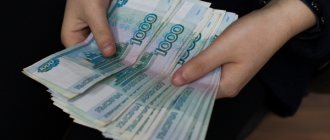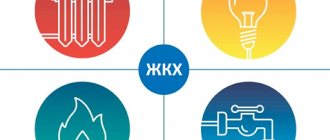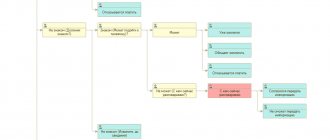Payment of housing and communal services for garbage removal
In 2021, a bill was passed that aims to solve the pressing problem of waste disposal. Previously, fees for waste removal were linked to the general “house maintenance” item. According to the highest authorities, this state of affairs had a negative impact on the quality of service to the population.
From January 1, residents will be charged separately for waste removal. The general tariff is determined based on the cubic capacity of the apartment. According to general information, 2.5 rubles will be charged for each square meter of living space. This money will be used to pay for the services of companies with which residents will enter into an appropriate agreement. Depending on the company’s tariffs and the decisions made by the municipality, the final price for the population will be determined.
In 2021, regional operators will set tariffs in this area. Uniform rates will apply throughout the region, so the selected operator will take responsibility for all apartments. The prospects for the development of the above bill note the idea of creating large waste processing enterprises that can serve several large regions simultaneously.
Do I need to pay for additional services?
The management company must carry out its work on the basis of an agreement that suits the residents. If apartment owners decide that they need something additional regarding the maintenance or maintenance of the house, they can hold a general meeting with a representative of the management company and make additions to the agreement.
What to do if the Management Company, on its own initiative, decided, for example, to place a concierge in the foyer of the house and include the cost of his salary in the item “Maintenance of the house”? Residents can refuse this additional service or, conversely, agree to additional costs, feeling the convenience.
Payment for housing and communal services for hot water
Every citizen can install special devices in their apartment to measure hot water consumption. If there is a meter in the premises, payment for the use of hot water will be made according to generally accepted tariffs in the region. To calculate the fee for the resource used, the following formula is used:
Р=V*T
P – amount of payment for SHG;
V – volume of water recorded by the meter on a certain date of the month;
T – cost of an installed resource unit.
When using this formula, you must remember that it is not applicable to those apartments that are serviced at two-part tariffs.
In the absence of special accounting equipment in the apartment, a fundamentally different calculation formula is used:
Р=к*N*T
P is the amount of payment for SHG;
k - the number of residents of the house who are registered or temporarily reside in the apartment;
T – tariff applied within a specific region.
A subsidy is issued for hot water consumption if the owner has legal grounds to receive the benefit. The amount of the discount can be found in the receipt, which is created individually for each user.
Poor quality delivery
When the residents of a house are well aware of the contract for house maintenance, they can monitor the performance of services and, if their quality is poor, complain to higher authorities. Who will consider the complaint? Lawyers recommend filing a collective complaint or claim; it will give greater effect:
- First of all, you need to complain about the work of the management company to its management. Perhaps someone will be skeptical about this method of influencing janitors or plumbers, but management may not be aware of the negligent work of their employees.
- If the management corresponds to its team, you need to write a complaint to the Housing Inspectorate, to Rospotrebnadzor. These bodies have the ability to influence the management company and other institutions in the public utilities sector.
- If there are facts of fraud or misappropriation of residents' money, you can contact the prosecutor's office. But the complaint must be accompanied by significant evidence of wrongdoing.
- And the last step is the court, it also needs significant evidence in the case, as well as regarding attempts to pre-trial resolve the problem.
Payment of housing and communal services for the elevator
The new method of calculating fees for elevator cleaning and maintenance is aimed at maximizing the efficiency of providing services to the public. Under the new rules, the elevator is the common property of the owners of the apartment building. By making deductions under this article, the owner provides:
- creation of reliable communication with the dispatcher, maintenance of cabin equipment used for communication;
- carrying out repairs, inspections and technical adjustments of the cabin and the entire system;
- urgent service in case of an accident;
- carrying out technical examination;
- testing the system after replacing electrical equipment or additional elements.
It is worth considering that work on elevator maintenance is carried out constantly. The amount of payment for all of the above work is determined on the basis of the share that belongs to the specific owner. The share is defined as a percentage of the total property of the owners of an apartment building. Responsibility for paying for the work falls equally on all owners, regardless of what type of real estate a person owns and on what floor his own property is located.
How is this different from a major overhaul?
The latter, unlike the current one, provides for the replacement of the building’s load-bearing structures. The roof, foundation, basements, in-house engineering systems, facade are being repaired, the area around the house is being improved, etc. This repair, unlike the current one, is not free, and the costs for it are often quite high (although money can come not only from homeowners, but also, for example, from budget funds). But it allows you to eliminate the wear and tear of the building. Major repairs also have their own frequency: it depends on the material of the floors, roofing and engineering systems. You can find out the procedure and timing of it, as well as the place of your house in the queue for major repairs (unless, of course, you live in a newly completed new building) either from the management company or HOA, or from the housing and communal services service, or from the city administration.
Housing and communal services payment for electricity
In 2021, electricity tariffs will increase by 7.1%. Today, in addition to the cost of consumed kilowatts, the population also pays a subscription fee. It is not calculated according to established rules, but is charged in hard cash. Last year, citizens paid 20 rubles a month for the use of electrical appliances.
The state allows the installation of special meters in residential premises that record energy consumption at different times of the day. Thus, each consumer can distribute the day into three periods, assigning a certain value to each period. Such innovations allow for more efficient use of electricity and savings on utilities.
You can also reduce costs and save time by using the Internet to pay off your electricity debt. Today, every owner can access a special online service, which, if they have an active bank card, will allow them to pay off their bills without leaving home. Access to mobile applications is also free. When using some online services to pay for housing and communal services, no commission is charged.
Features of accounting in HOAs
HOA is a non-profit organization whose members are the owners of apartments in apartment buildings. This structure is also being created for the purpose of effective management, sanitary and technical maintenance of apartment buildings.
Accounting for costs and materials is carried out similarly to accounting in the Criminal Code. And here are the DS coming in:
- as membership fees of HOA participants;
- targeted funding from the budget;
- commercial activity carried out with the aim of attracting additional income.
Read more about the procedure for maintaining accounting in HOAs in the material “Basic rules for maintaining accounting in HOAs (nuances).”
Due to the fact that the activities of the HOA are carried out according to estimates and are not intended to make a profit, the taxable financial result will be equal to zero, provided there is no additional business activity. And payments by owners for HOA services are membership fees and relate to targeted financing, taken into account in account 86 “Targeted financing”. In this case, input VAT is included in costs.
Most often, the HOA also carries out the collection and distribution function between the resource supplying organization and resource consumers (see Diagram 1). But since the HOA does not charge fees for intermediary services, these funds are also targeted and are accounted for in account 86 “Targeted Financing” (letter of the Ministry of Finance dated October 29, 1993 No. 118), and utility payments are reflected in transit through account 76.
| Dt | CT | Content |
| 76 | 86 | Obligatory payments for utilities were accrued to the owners of apartments in MKD according to the estimate |
| 10 | 60 | Materials purchased |
| 20 | 10 | Materials written off |
| 20 | 60 (76) | The costs of purchasing services are reflected, including VAT |
| 26 | 60 | HOA management costs |
| 26 | 70 | Salaries of HOA management personnel |
| 51 | 76 | DS were received from the owners of apartment buildings for the services consumed |
| 60 | 51 | Utilities of resource supply organizations have been paid for |
| 86 | 20 | Owner contributions are aimed at paying off costs for consumed services. |
In the above-mentioned letter of the Ministry of Finance dated October 29, 1993 No. 118, it is recommended to use account 96 to account for target funds. The differences between the accounts are associated with the approval of the new chart of accounts by order of the Ministry of Finance dated October 31, 2000 No. 94n - the 86th is the “successor” of the old 96th account.
In addition to the statutory activities, HOAs can engage in business.
Accounting for commercial activities is carried out similarly to accounting in the Criminal Code, but the profit from it is not distributed among the management or members of the HOA, but is used to achieve the goals of creating a partnership (Clause 4, Article 50 of the Civil Code of the Russian Federation). The wiring is as follows:
- Dt 99 “Profits/losses” Kt 84 “Retained earnings (uncovered loss)”.
- Dt 84 “Retained earnings” Kt 86 “Targeted financing”.
Income and expenses from the business activities of the HOA are included in the tax base when taxing profits (or simplified tax system).
ConsultantPlus experts explained in detail how HOAs keep records of income and expenses using the simplified tax system. To do everything correctly, get trial access to the system and go to the Ready solution. It's free.
Payment for housing and communal services for heat
Calculation of payments for heating has a fundamental difference from other areas of housing and communal services. The fact is that the basis for calculations is not the amount of heat consumed, but the total cubic capacity of the apartment. However, recently, special devices have begun to be introduced into everyday use that allow you to control the level of heat in the house as part of central heating. Meters allow you to significantly save money during the heating season. An example of calculating the amount of payment for heating is as follows.
At the end of the month, the heat meter recorded 3 gigacalories. According to the current regional tariff, 1 gigacalorie costs 1,200 rubles. The calculation will look like this:
3*1200 rubles=3 600 rubles
The lack of an metering device forces the use of generally accepted rules for calculating heating payments, according to which a certain amount of heat is required for each square meter of the apartment. Let's look at an example.
Regional authorities have established a tariff according to which 0.03 gigacalories per square meter of living space. According to the tariff, 1 gigacalorie costs 1,200 rubles. The total area of the premises is 120 square meters. The calculation looks like this:
120*0.03*1,200=4,320 rubles
It is worth considering that for houses in which communal metering devices are installed, this calculation method is not used.
How house maintenance work is divided
The works included in are divided into several groups. Some are planned, carried out to maintain the high technical condition of the house, and usually involve routine repairs.
There is also a group of seasonal works, they allow you to prepare the house for the heating season. Also, some work in the local area is seasonal. The service company must quickly and efficiently carry out various necessary work - repairing a broken water pipe or electrical network, for example.
Payment for a housing and communal services janitor
Deductions to janitors who clean areas near entrances are made from the residents' cash receipts. This service is included in the structure of the “house maintenance” direction. It is from the fund of these deductions that payments are made to the janitors.
When paying for housing and communal services, residents pay for house maintenance services:
- cleaning areas, parks, sidewalks, roads that are located as close as possible to an apartment building;
- creation of lighting in the yard;
- systematically maintaining cleanliness around the house;
- measures for landscaping;
- maintaining optimal air humidity levels inside the house;
- creating a safe environment;
- waste removal.
These are not all the activities that are carried out within the framework of this housing and communal services. Based on the results of the general meeting of owners, decisions can be made to introduce changes in the area of improvement of the territory.
Results
Accounting in the housing and communal services sector is not regulated by separate norms of accounting legislation. In this regard, companies independently develop accounting procedures based on the general rules and principles of PBU, instructions, methods and explanatory letters from the Ministry of Finance and the Federal Tax Service.
Sources:
- Tax Code of the Russian Federation
- PBU 10/99, approved. by order of the Ministry of Finance dated 05/06/1999 No. 33n
You can find more complete information on the topic in ConsultantPlus. Free trial access to the system for 2 days.








